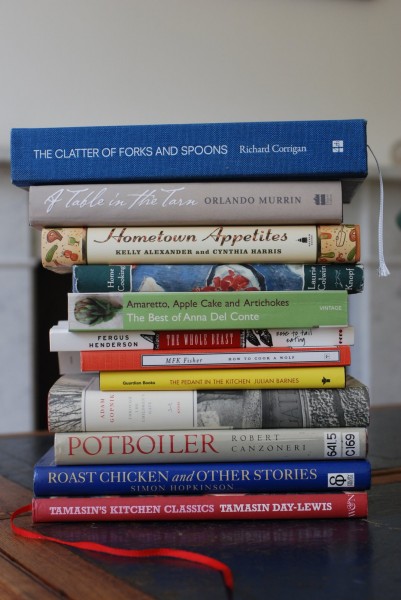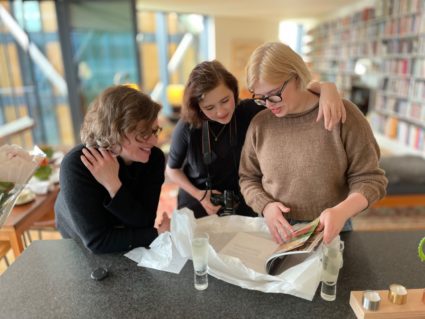an ever better meatball

But before I get to the recipe, can I just say that I love cookbooks. Well, not so much what you’d define as strict cookbooks. What I gravitate to is a story: the story of a life, punctuated with food. I tend to like to WRITE the sort of thing I like to READ. So it’s no accident either that I’m working so jolly hard on setting down MY stories and recipes, nor that I spend the rest of my time reading other people’s. And then of course there’s the added layer of cooking their recipes, to varying degrees of success.
Lately, though, my writing project has become a blurred confusion to me. I can no longer decide if any of my chapters are worthwhile, if any of them make sense, much less achieve that nirvana-like state called “flow.” In all my previous writing life — schoolwork, dissertation, art reviews and the like — flow was never anything I thought about. The writing just DID. Flow. I was the sort of writer who irritated other writers, because in general the first draft was just fine, so I developed a lazy strategy in which the first draft was the last draft.
Not anymore.
I have diagnosed my trouble as being a case of caring too much. Always before, my writing projects were intellectual pursuits, and mostly a means to an end. But now each memory, each anecdote, each chapter takes me back to a cherished part of my life, with treasured people and irreplaceable context. It all matters too much! So I’m becoming labored and tormented and un-natural. No flow.
The solution, everyone tells me, is to find a structure for the book and then let the various ideas I have for filling it find their proper slot in the structure. Like having rules to a game so the players don’t just flounder around running into each other. When I wrote my dissertation, my advisor gave me a piece of invaluable advice: imagine your whole book as a chessboard. Each one of your ideas will play a role, and you simply assign them to their place on the board, then flesh them out. I had no difficulty in doing that, for the purposes of a feminist analysis of late 19th-century sculpture in France. Somehow, doing the same thing for meatballs, macaroni and cheese and vichyssoise is proving much trickier and fraught with danger and confusion.
Let’s see: the choices for structure are these. I could organize it chronologically as I lived my life, starting with childhood memories and food, running right to the present. Or I could organize it seasonally, picking out seasonal events and memories and setting them in order. Or it could be arranged by types of food (this sounds the least appealing to me, since the book isn’t primarily about food). I’m sure there are other organizing principles that haven’t occurred to me.
So I’m in a bit of a block.
Reading everyone else’s highly accomplished work helps on one level, in that it gives me something to strive for, a standard to meet. But the flip side of that is that I look at my own work and find it wanting. And of course no book reads exactly like another, and mine needs to find exactly its own voice and structure too. Sigh, double sigh.
How about something practical? Let me tell you what NOT to do with your crab tart should you decide to make it. The mistake I made yesterday would have flattened my confidence several months ago, but having racked up some hours in the baking department, I felt that surely I had made just one error, not even a disastrous one, and the key was to find it, and not to do it again. I’ll explain.
Baking is a scientific process, as you know (I am in constant denial of this fact, to my peril). I can’t just add a little of this, a little of that and expect it to work, as I do with soup, or pasta sauce, or meatballs. I also cannot ignore the process itself, the rules and sequences of activity. Well, needless to say, I did. Yesterday, for my beloved Lost Property group from Avery’s school.
Lost Property. There is something amusing about the name, when you first hear it, and when someone first approaches you at a school tea wearing a badge that says, “Molly, Lost Property,” your first reaction is bemusement. The designation sounds like a pathetic label worn by a child on a railway platform during World War II in Eastbourne. In truth, it’s the single coolest volunteer opportunity at the school, in a sort of chicken-and-egg sort of way. Was Lost Property cool, and so cool people joined, or were the very first LPs extraordinary to begin with? We are well known for hosting an epic luncheon of majestic proportions at the start of every term, each term hosted by a different volunteer mother (me, yesterday), and attracting positively Lucullan contributions in every course. I may say indiscreetly that the wine is contributed by a Master of Wine (not many are women, apparently), who burst into the meeting saying, “Have you a radio? Someone turn it on to Radio 4, I’m speaking.” The main courses were monuments of elegance, the salads luscious, the cheese board ridiculously magnificent.
I was more than happy to enlist John’s help in bringing up a banquet table from the basement, borrow chairs from my Lost Property friends up the street, make my friend Annie drive me all over West London searching for crabmeat for my darling tart. Then the vintage linen tablecloth, the many mismatching dinner plates, salad plates, EVERY silver fork and knife polished by me the day before… I drew the line at cloth napkins, however. For 30? Not in the mood.
But the tart. I was putting it together the night before the lunch, while also grilling salmon, finishing cream of mushroom soup from homemade stock, steaming rice and sauteeing broccoli for dinner. And somewhere in the middle of all this, accompanied by Avery’s singing “The Bare Necessities” and playing “Fur Elise” endlessly on the piano, I decided it would be best to bake the tart halfway, refrigerate it overnight, and finish baking it the next day just before the luncheon.
Well, I can tell you that this strategy is a disaster. There is some chemical reaction in the cooking process with things involving eggs (I think) that means you CANNOT stop the process halfway through, a quarter of the way through, any PORTION of the way through, and hope for success. How did I find this out? Because when I took the tart from the oven at serving time, somewhere about halfway through the champagne, I could see that the filling had not set. Not nearly enough. I put it back in the oven, turned the heat up slightly. Guess what happened then? Any extra butter or cream or BOTH from the filling slipped quietly out of the springform pan and onto the bottom of the oven floor and while it didn’t actually catch on FIRE, it produced a noxious smoke that billowed into the kitchen when I opened the oven door. Shades of my parents’ first Thanksgiving when their turkey fat exploded on THEIR oven floor.
I managed to ask someone quietly to open the garden door, someone else to open the front door, turned up the exhaust fan as high as it would go, and executed a sleight of hand manoeuver to liberate the tart from the oven and SHUT the door as quickly as I could. No harm done.
And I have to say that the tart was eaten, every last slightly gooey morsel, instantly. Several ladies complained that they did not get second helpings. But I learned my lesson. Cook it all at once. That’s all you need to know.
Tonight I redeemed myself somewhat. Having felt uninspired for cooking dinner, I jumped in with both feet and decided to make Moroccan meatballs. Always a good idea, and tonight it turned out to be an even better idea than ever before, in a most unexpected way, I might add. I have always had a warm place in my heart for the “kefta,” the Lebanese lamb mixture I obtain at Green Valley in Edgware Road, for the meatballs. I have nourished a romantic attachment for the mysterious and unnamed ingredients in this meat mixture, an ambrosial elixir of gently spiced and exotic deliciousness.
Tonight, however, John did the shopping, and not at Green Valley. “Just buy lamb,” I advised, “and parsley and garlic.” So at home I chopped flat-leaf parsley super-fine and minced garlic and squished in ras el hanout, that irreplaceable aromatic spice blend from Morocco, mixed it all with the lamb, kneaded it like bread dough and formed meatballs, which I dropped into the simmering tomato sauce to poach. And do you know what?
FAR BETTER than the mix from the Lebanese market! So fear not, any more, my friends who do not have access to a foreign market. Mix your own. Just gorgeous. With eggs poached at the last minute into the top of the bubbling, garlicky sauce, there is nothing nicer on a cold, windy, rainy January London night.
It turns out: after all this thinking about my writing, with this experience I produced a second draft of my meatballs and it was an improvement. A lesson learned. Enjoy.
Lamb Kefta Meatballs with Tomato Sauce and Poached Eggs
(serve about 6)
1 kilo lamb mince, mixed with 1/4 cup chopped flat-leaf parsley, 4 cloves minced garlic and 1 tbsp Moroccan ras el hanout spice, rolled into little 1‑inch meatballs
1/2 cup vegetable oil
4 cloves garlic, minced
1 white onion, finely minced
2 large cans peeled plum tomatoes
1 tbsp ras el hanout
1 1/2 tbsps ground cumin
1 tbsp lemon-ginger powder
1 tbsp sweet paprika
1 tsp cayenne pepper
1 tbsp salt
fresh ground pepper to taste
5 extra tbsps fresh chopped flat-leaf parsley
In a very large, heavy-bottomed deep saucepan, saute the garlic and onion in the oil and add the tomatoes, breaking them up with your hands as you put them in. In my humble opinion, there is no place in this life for tinned chopped tomatoes. Don’t you wonder what sort of tomatoes they use when they know they can get away with them not looking like a tomato? Just buy whole and break them up during the cooking process, I say. Add the spices and the parsley.
This sauce must simmer for at least two hours, but it can sit almost indefinitely.
About an hour before you want to serve the dish, drop the meatballs into the sauce, in one even layer, as many as you can fit (we ended up with 30 meatballs and they all fit). Then cover the pan and leave to simmer for 20 minutes. Again, these can sit almost indefinitely with no risk of becoming tough.
When the meatballs are thoroughly cooked and you are about 10 minutes away from serving, break eggs, one at a time, and lower into the sauce, as many as you can fit (we managed about 4). Cover and cook until the eggs are poached, about 8 minutes. Throw the remaining parsley on top. Resist the temptation to play with the eggs until they are cooked through! A bite of egg yolk and a bite of meatball smothered in the sauce was… divine.
This dish smells like nothing in this world. Your guests will feel they have died and gone to heaven, and you will be a star. I served this with steamed potatoes drizzled with olive oil and sprinkled with parsley, and a salad made of cucumbers and dill in sour cream.

